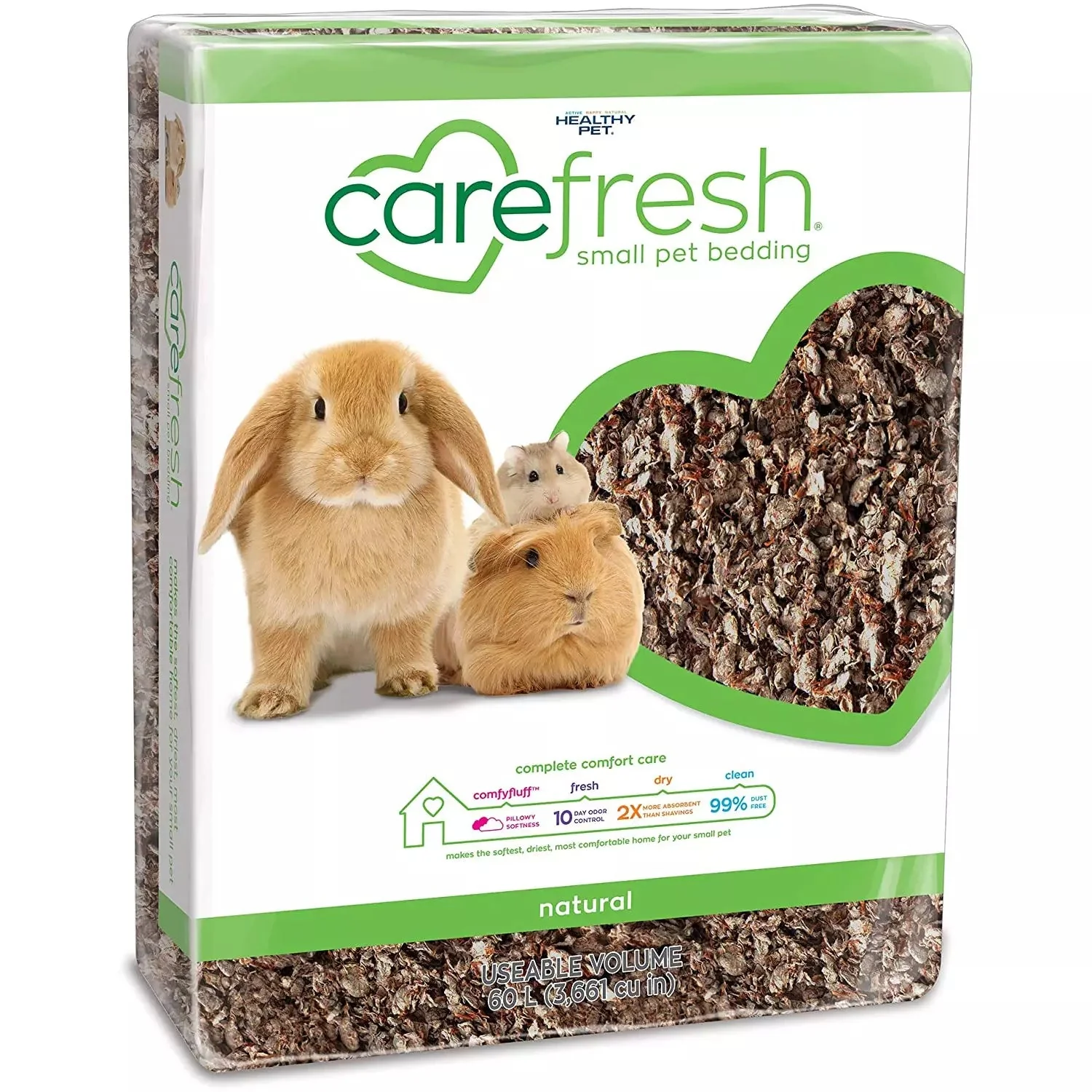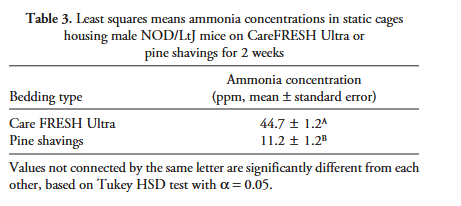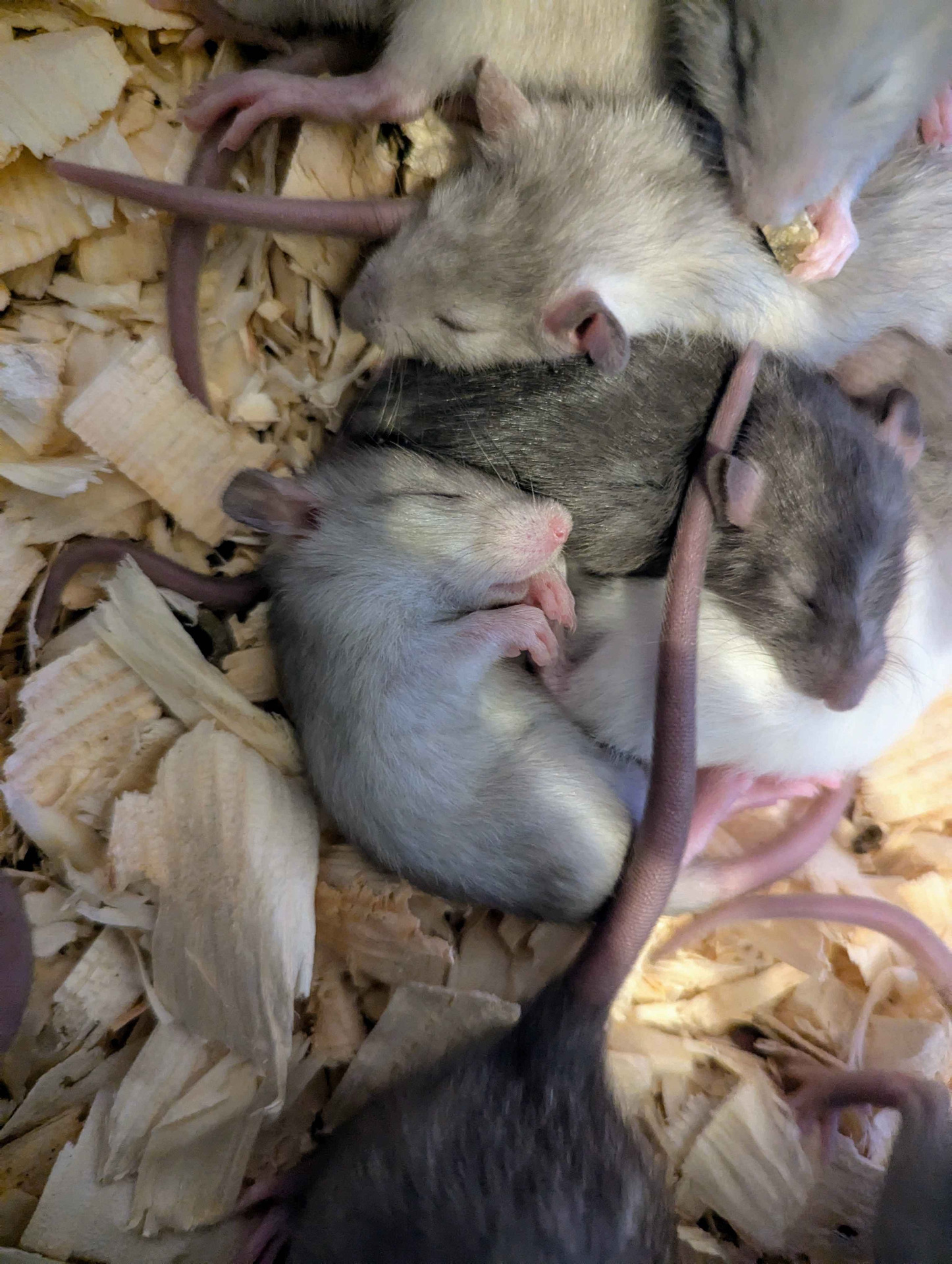What bedding really is best for my rats?
Many places will recommend paper bedding over traditional wood beddings such as pine and aspen, fear mongering how they are dangerous due to the fact that they contain what is known as a “volatile organic compound” (VOC). While VOCs are harmful compounds, the kiln-drying process gets rid of these volatiles, rendering the bedding dry and safe. All farm and pet-grade softwood bedding will be kiln-dried in advance to remove moisture and potential pests.
 CareFresh and Kaytee "Clean & Cozy" are two of the most common
CareFresh and Kaytee "Clean & Cozy" are two of the most common
paper beddings found on the market
Despite the advertisement of paper beddings being “dust-free,” paper bedding is also full of fine particles, which can inflame the respiratory system of rats. On top of this, paper lacks proper ammonia control. It has been found that paper bedding (CareFRESH Ultra) holds a significantly higher concentration of ammonia, accounting for nearly four times that of pine.
 Source: Evaluation of cage micro-environment of mice housed on
Source: Evaluation of cage micro-environment of mice housed on
various types of bedding materials
Ammonia is the biggest contributor to respiratory irritation and subsequent inflammation in rats, as it destroys the cilia present within the lungs. Cilia are small, finger-like projections in the respiratory tract of all mammals, and work alongside mucous to push out dust, dirt, and harmful pathogens. When cilia are destroyed, pathogens will increase in number within the respiratory tract, resulting in severe respiratory illness in rats.
For reference, 100ppm causes irritation long term in humans. We detect from 5ppm onward, so ideally you want a maximum of around 5ppm present in the cage at any given time. In a week’s time, pine shavings will produce, on average, about 4.4ppm. Weekly changes of paper bedding on the other hand would build up to a solid 61ppm.
What we consider the legal OSHA approved limit in people (based largely on rat studies) for chronic workplace exposure is 25ppm:
"The US National Institute of Occupational Safety and Health (NIOSH) recommendations state that the maximum permissible time-weighted average (TWA) exposure of anhydrous ammonia for an 8-hour workday of 40 hour-week is 25 ppm. The short-term exposure limit (STEL) or the concentration at which exposure of longer than 15 minutes is potentially dangerous is 35 ppm. The concentration at which the gas is immediately harmful to life or health (IDLH) is 300 ppm.”
Keep in mind that rodents have a significantly more sensitive sense of smell than we do, so the detectable odour of ammonia is noticeable to them much faster than it would be for us. In a rat cage, a rat will be much more closely exposed to ammonia, even at lower concentrations, than that of us in the same room due to the close contact with bedding and soiled hammocks.
On top of being hazardous, the bedding gets stinky FAST. Shredded paper bedding needs to be changed roughly every 3 days to keep it acceptable, whereas softwoods require weekly changes instead. Paper bedding is also very expensive in comparison, and many formulations have unnecessary added dyes, perfumes, and baking soda added to mask the odour control it lacks.
There are no benefits in using paper. Using paper will cost more not only upfront, but in costly veterinary bills due to increased respiratory illness.
You may ask yourself: “Are there any situations when shredded paper is a good option?”
The answer is no, not really. In modern laboratory facilities, softwood bedding is the preferred and recommended choice in rodent cages due to the reduced dust and excellent ammonia control it provides. This is used as the standard in both the United States and Europe, as outlined in the Guide for the Care and Use of Laboratory Animals. Additionally, the paper bedding that is available for laboratory use is higher grade than that of the bedding available for pet grade, due to the requirements for continuity and safety in the lab. Paper bedding found in laboratories is significantly less dusty, and designed overall for use in different circumstances.
If you have bought paper bedding and are now reading this article panicking - do not fret! It is okay to use the bedding up until you get proper bedding as this will only be a temporary situation.
If you are still uneasy about using wood bedding or you have allergies to woods, hemp or horse-grade cardboard are great alternatives.
Sources
Evaluation of cage micro-environment of mice housed on various types of bedding materials - E. Smith, Stockwell, Schweitzer, Langley, and A. Smith, 2004 (PMID: 15264763)
The effects of chronic exposure to common bedding materials on the metabolic rate and overall health of male CD-1 Mice, Becker, Mathur and Rehnberg, 2010 (PMID: 20017045)
Effect of bedding materials on concentration of odourous compounds and Escherichia coli in beef cattle bedded manure packs, Spiephs, Brown-Brandl, Parker, and Miller, 2013 (PMID: 236373740)
Ammonia Toxicity - Padappayil and Borger, 2023
Guide for the Care and Use of Laboratory Animals, 8th edition - National Research Council (US) Committee for the Update of the Guide for the Care and Use of Laboratory Animals, 2011 (ISBN-13: 978-0-309-15400-0)
Volatile Organic Compounds (VOCs) from Wood and Wood-Based Panels: Methods for Evaluation, Potential Health Risks, and Mitigation - Adamová, Hradecký, and Pánek, 2020 (PMID: 33036167)
Voltaile Organic Compounds Emitted from Untreated and Thermally Modified Wood - A Review - Pohleven, Burnard, and Kuntar, 2019 (DOI: 10.22382/wfs-2019-023)
Kiln Drying Beech Wood: Techniques and Benefits - Rhodri Evans, 2023 (Source: Hillside Woodfuels)

